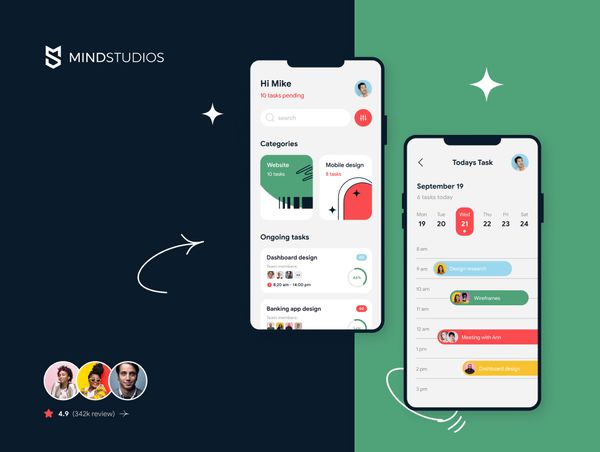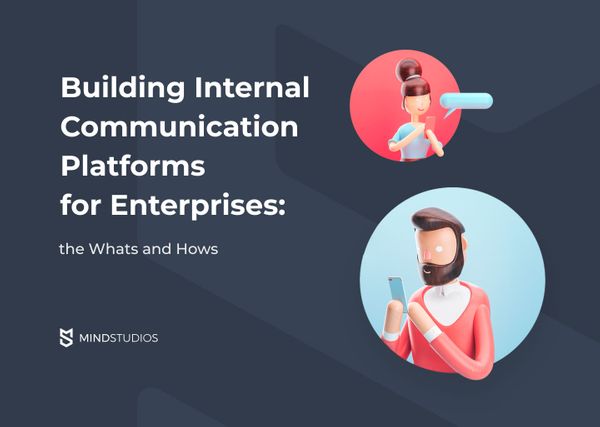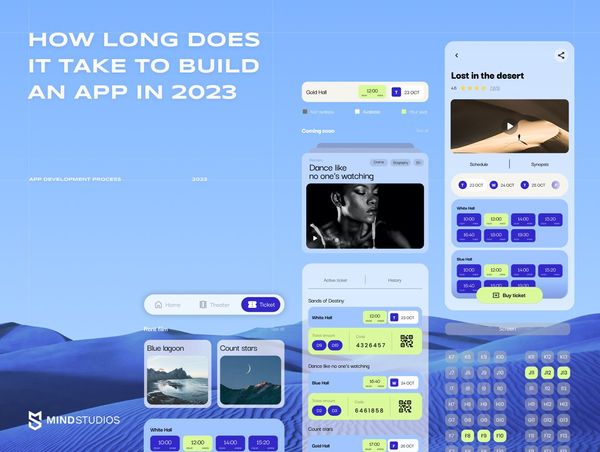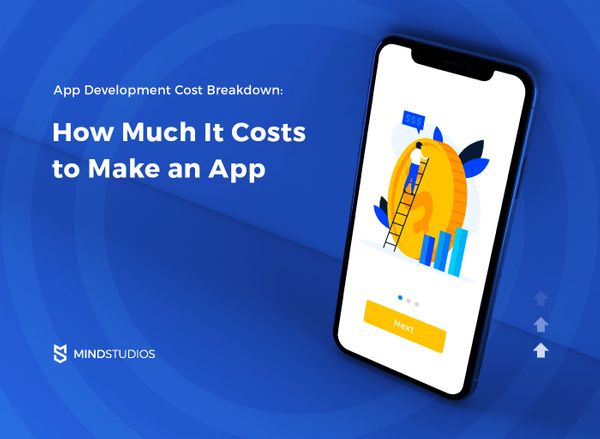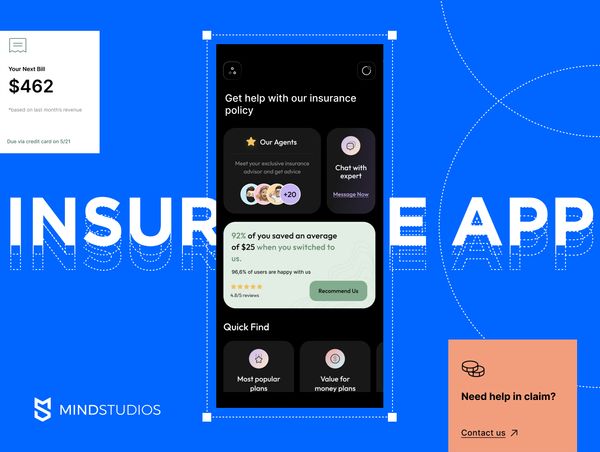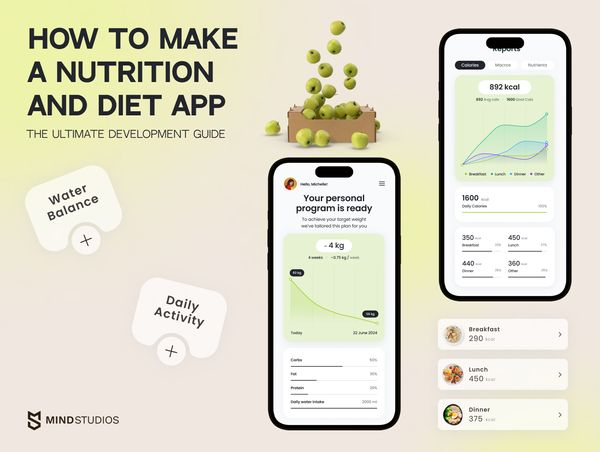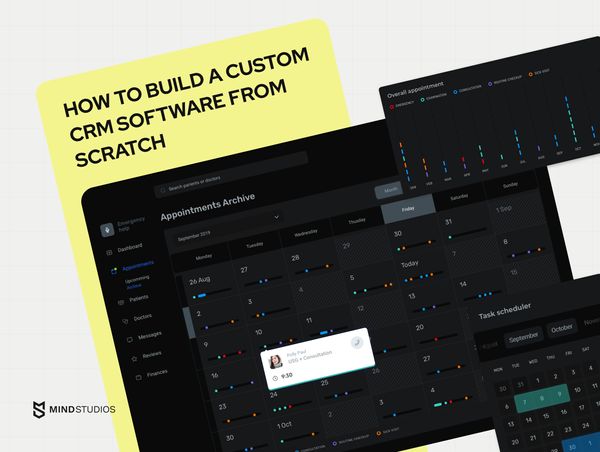
Today, it's hard to imagine a company operating without a CRM system. However, not always the CRM users' expectations are met. For example, the MarTech Replacement Survey 2022 conducted among 300 marketing companies showed their teams were replacing marketing automation and CRM solutions at a higher rate than any other applications. Why so?
When entrepreneurs apply to us to build a custom CRM system, usually we observe three main cases:
- The number of clients increases greatly, so the Google Sheets no longer work
- The complexity of processes caused by business growth requires custom-build solutions that current CRM systems haven’t covered
- With the pay-per-user model, using SaaS software is no longer economically feasible compared to creating their own CRM system
Whatever reason brings you to this article, we’ll get you covered with a complete guide on how to build a CRM software for your own B2B or B2C company or develop a CRM SaaS platform that you can sell to others.
“We recommend our clients to make CRM a part of their strategy before the number of customers makes CRM software absolutely necessary. Even if a project doesn’t involve CRM software development, we always equip its admin panel with the user management section. As the project grows, it can be transformed into a multi-tier CRM system.”
— Anton Baryshevskiy, Mind Studios Co-founder and Head of Business Development
Buying a CRM system vs Developing your own
If you want to provide CRM services in a SaaS sort of way, it’s clear you need to build your own CRM software from scratch. However, if you’re looking for a system to use with your current business, you can buy a subscription service from a company like Salesforce instead of diving into custom CRM development.
Using a SaaS platform is a valid option. But it has its shortcomings, as everything does.
1. It might actually be too much
According to the study from Forrester Consulting, the top four challenges for SaaS CRM buyers are associated with difficulties in setting up, making changes, integrating third-party tools, and training users.
Ready-made CRM solutions have just about every feature one can think of.
But there’s a flip side: the software is often cumbersome and overloaded with the functionality you might not need, let alone it could lack something you pursue in your company’s unique workflow.
2. It might not be the cheaper option in the long run
Existing CRM solutions charge from $10 to $250 and more per user per month. So if you have 100 employees, you’ll be paying at least $12,000 in a year for as long as you use the CRM — sounds acceptable so far. But once your team expands to 1,000 people, you’ll need to pay a frighteningly high $120,000 per year or more. More people in your company — more money to cough up. Need more features? Again, more money.
In this case, does it seem reasonable to spend a one-time $100,000 and create your own CRM software with the perfect balance of features that fit your business?
If you find that a custom solution is what you really need, check out our answers to more CRM-related questions below.
Features that should be included when creating a custom CRM
Whether you’re building a CRM system for your own company or to offer software as a service to other companies, you’ll first need to set priorities. Some features for custom CRM systems will be critical, whereas others will be secondary.
Let’s see what features are usually required in custom CRM software.
Customer database
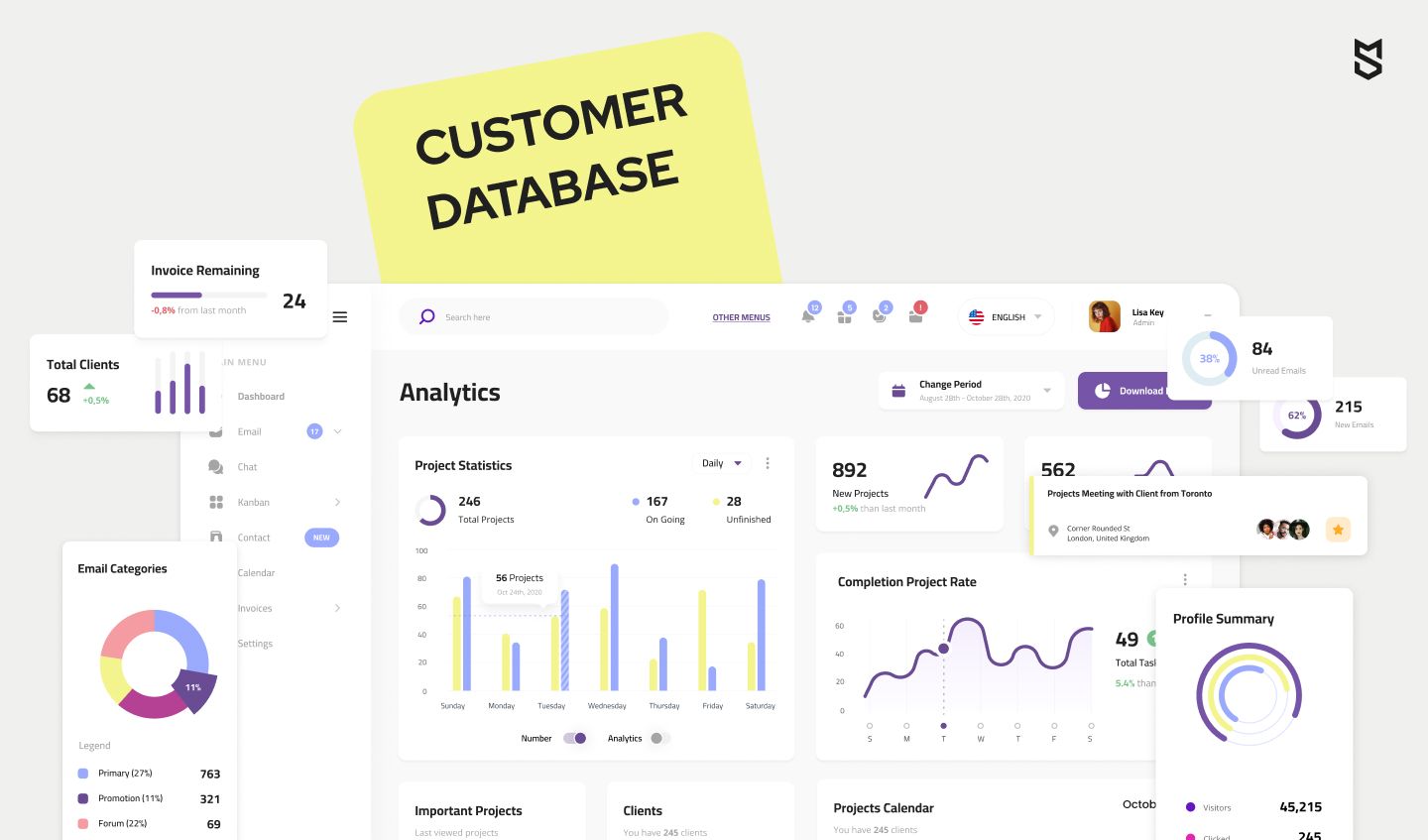
The core of any CRM system is the database. This is where all the information about your customers is stored:
- Names
- Email addresses
- Phone numbers
- Addresses
- Links to social media pages
- Work and family info (if necessary)
For B2B companies, there should be information on partner companies that includes the name of the CEO, information about the contact person or contractor you communicate with, financial data, addresses, phone numbers, etc.
It’s possible to allow users to add initial customer data manually. In fact, this is easier to do from the developer’s point of view. However, more and more custom CRM solutions provide automated list building.
The system can be set up to collect data from emails, social media, or forms your customers fill out on your website. Adding automatic list creation will free some time for your agents to interact with prospects, leads, and existing customers.
Automatic or manual, the database absolutely must be searchable — it will save time even if you only have a few dozen customers.
Segmentation
This is database-related functionality aimed at marketing departments. Successful marketing is dependent on the right customer segmentation. You won’t be selling many snow chains to customers in Florida, will you? Or to people without cars?
Segmentation makes it easier to select groups of customers who are likely to react positively to a marketing campaign, which makes it a useful feature for marketing and sales analytics. Any CRM system must have segmentation functionality.
Sales pipeline tracking
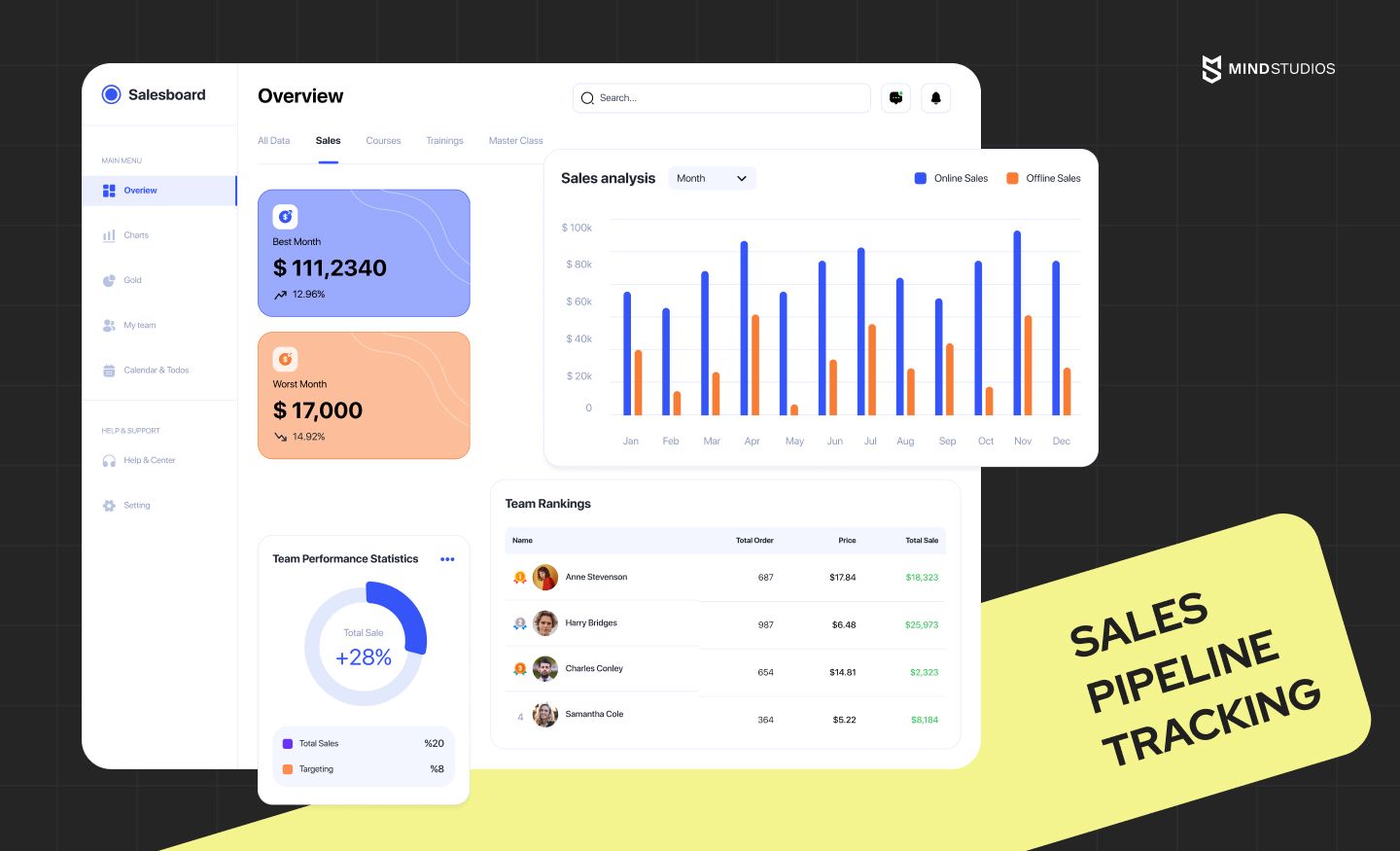
There should be a place in your custom CRM system where employees can track leads, starting at the first contact until either the deal is sealed or the customer is lost. If you plan to make a CRM software for your own company, you know the stages you need it to track.
If you’re aiming at providing SaaS solutions, it’s better to implement a customizable pipeline dashboard since your clients will each have unique sales pipelines.
Document upload and storage
An option to upload files isn’t a must, but it can be quite helpful and will save your managers from spending time manually recording important information sent by customers. A custom CRM system can seamlessly connect to cloud storage or email clients, or simply upload files from a device.
Smooth data import/export
This feature arises from the previous one. Based on your business specifics, your employees might require to upload/download quotes, invoices, records, templates, etc. from third-party sources in a particular format — CSV, Excel, or PDF, for instance.
To prevent them from entering data manually, you can equip your custom CRM software with an easy-to-use tool to import/export files of various formats. This will boost your team's productivity, allowing them to focus on more important tasks like closing a deal or handling negative reviews.
Template library
To streamline the workflow for your sales, marketing, and support teams, it seems to be a wise idea to provide them with an extensive library that holds templates for all occasions.
For example, when a prospect is putting off a purchase, receiving a relevant offer with some extra bonuses could speed up their decision-making. A ready-made message with a favorable offer and powerful call-to-action will be most welcome. For your sales manager, it will be just a matter of entering the prospect’s name and sending it to them within seconds. And this is just one of a million examples.
So having a template library can boost your sales and improve the customer support level. Consider implementing this feature in your custom CRM software development.
High-end data protection
Databases stored in CRM systems are full of sensitive information, starting with your customers’ email addresses and ending with their history of purchases. All this data must be protected with the most up-to-date security certificates. Skimping on data protection might cost you all your customers and even result in legal charges. Keep this in mind when you set priorities in CRM system development.
Scheduling functionality
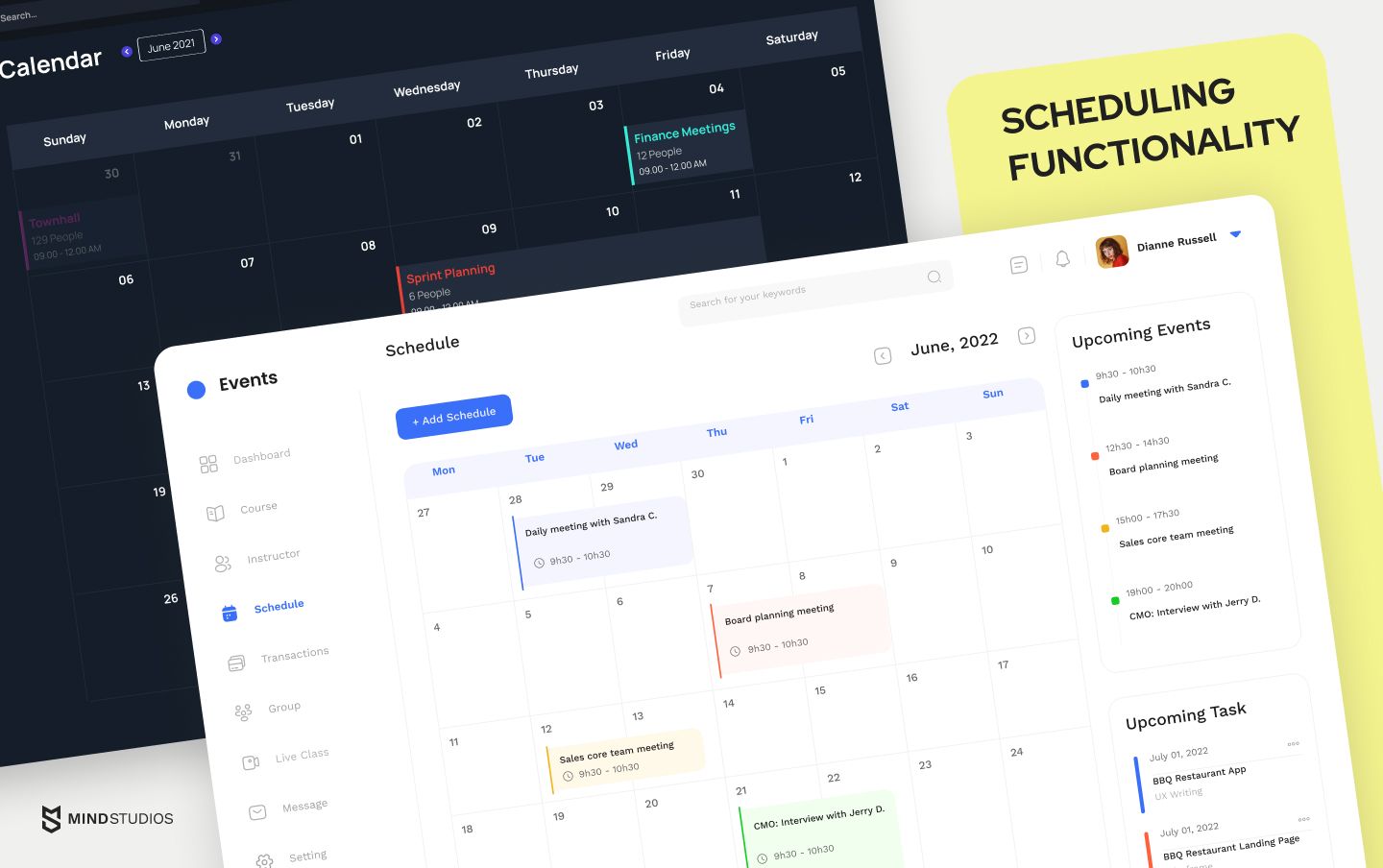
Every manager who has more than one customer needs a scheduling tool. Integrate a calendar into your CRM system so users can link their schedules to customer profiles and activities.
Google Calendar can be synced with a scheduling tool in a CRM system. This way, users will have access to their events from outside the CRM software. It’s also possible to implement schedule sharing within the team and between teams; this will enhance communication and team performance.
Users should also be able to browse all their planned activities.
And scheduling is incomplete without reminders, of course. You can remind users to make a follow-up call, hold a meeting, or launch a campaign. Reminders can be sent to a user’s email address or pop up when the CRM is active.
Automated analytics
CRM software should be able to match data and build an automatic analysis for campaign management, individual managers, clients, and more. Technically, it’s not too difficult to implement an analytics tool in CRM software. If all the necessary data is added diligently (either manually or automatically), a simple algorithm can draw performance diagrams and graphs based on it.
With an analytics tool, you can easily see sales history, track performance on a timeline, and monitor the effectiveness of each manager and campaign.
We recommend you add filters to your analytics tool to make it more flexible. Allow users to not just see a single campaign’s performance over the months but to compare two or more similar campaigns, for example. What channel brings more clients: email or Facebook ads?
Draw an automatic report to brainstorm with your team and deduce ways to improve performance.
Report-building tool
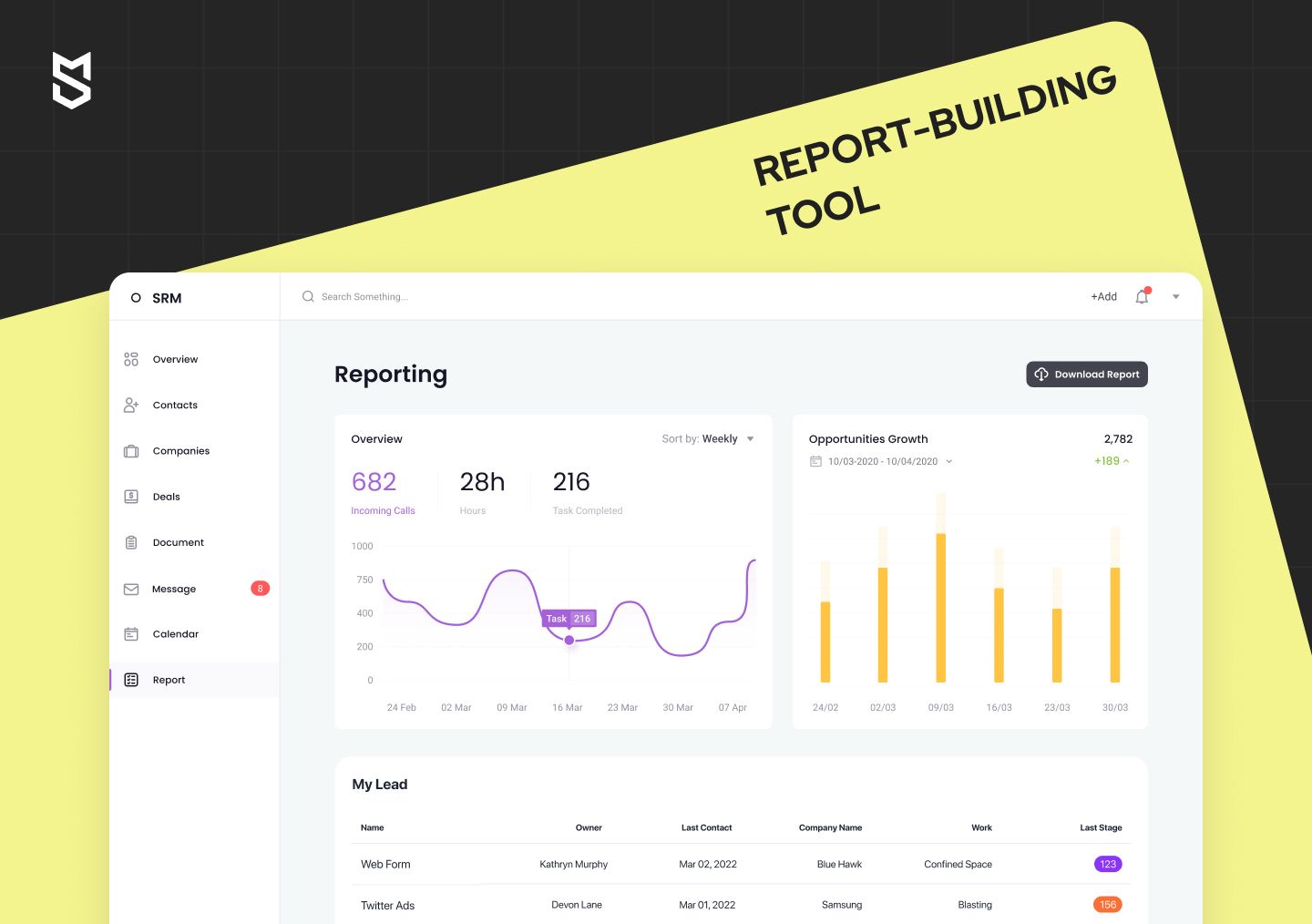
In addition to an automated analytics feature, it’s essential to provide your custom CRM software users with an advanced report-building tool. It enables users to share the reports via different options including email and chat and download the reports as PDF files (or any other suitable format) to use them when offline.
Cloud integration
Everyone is moving to the cloud. And it’s no wonder — clouds are more stable, secure, and flexible. They’re also cheaper to maintain than data centers. Cloud services are a perfect option for growing businesses, although established enterprises can also benefit from them.
Email marketing automation
Surprisingly, despite the spread of other marketing methods, email marketing still brings the best results according to numerous studies. Email marketing can be automated and integrated into your CRM software.
If you integrate this functionality, users will be able to set parameters that trigger automated emails to specific segments of customers or prospects. From the first hello and welcome emails, lengthy marketing campaigns can be automated with email integration.
CRM integration via API
This feature will most certainly come in handy if you’re planning to build a CRM application from scratch to offer SaaS solutions to other companies. Why? Some companies use custom software. The ability to integrate your CRM into that software will eliminate the hassle of transferring data manually, which, in turn, will radically decrease the number of mistakes made and free more time for managers.
If you’re making a CRM system for your own company and your managers use other software, it will also be beneficial to create APIs and link that existing software to your CRM tool.
Chatbots
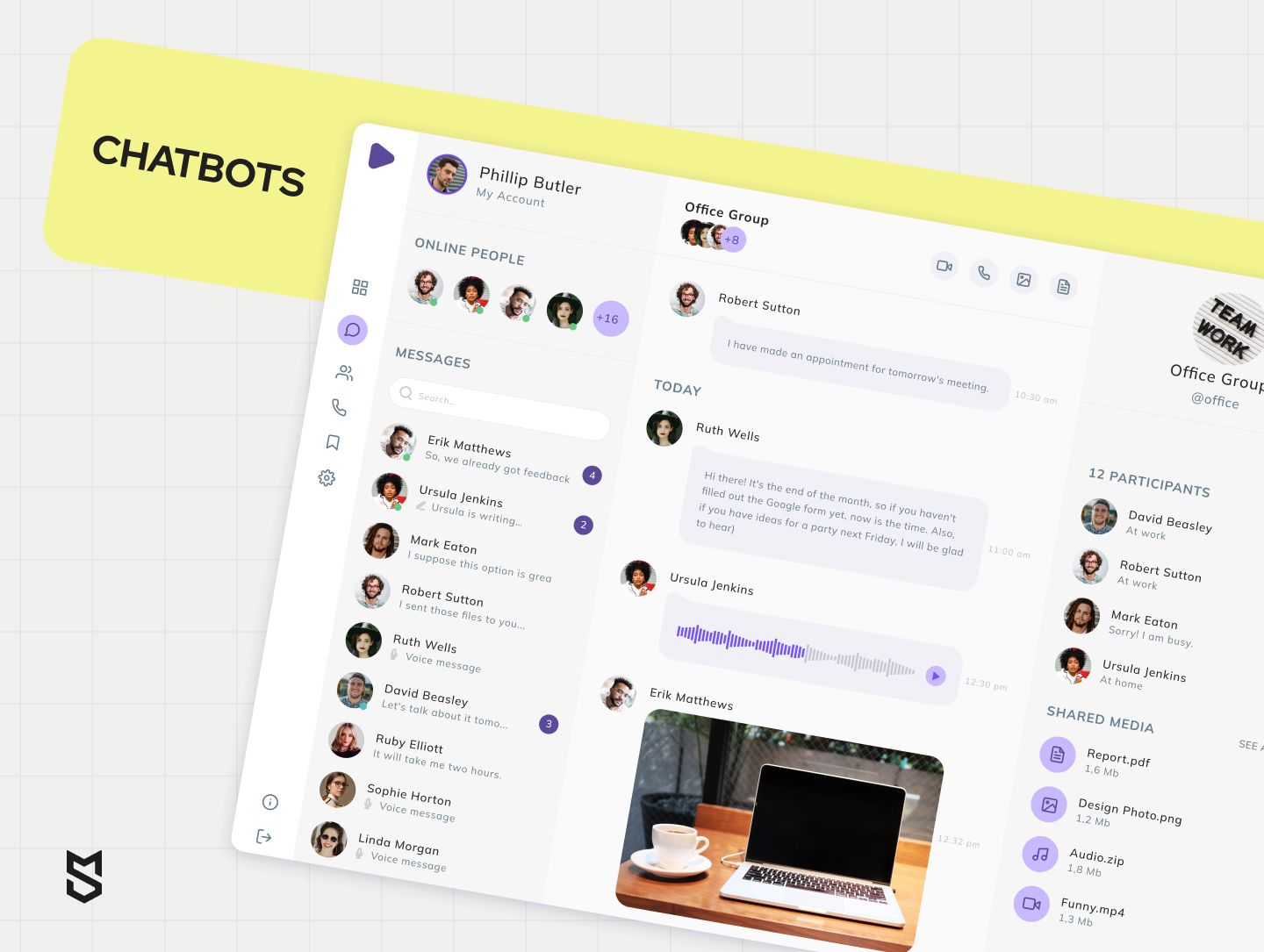
Artificial intelligence and chatbots are being used in more and more industries each year.
Chatbots can:
- Lower the load on your support team by answering frequently asked questions from customers
- Help your sales and marketing teams to segment prospects or established customers by offering various questionnaires
- Provide basic training to your new employees — again, by answering common questions
- Schedule meetings for all team members at once
- Automatically set up reminders for meetings, calls, and marketing events
These are all routine tasks that appear regularly and can be easily automated.
Design and Architecture of your CRM
To get a robust CRM system, you need to pay attention to its design and architecture. Here are some key considerations:
- Modular structure: Opt for a modular architecture that breaks down the CRM into distinct components or modules. Each module can focus on specific functionalities like sales, marketing, customer support, and analytics, making the system more manageable and flexible.
- Scalability: Plan for scalability from the outset to accommodate future growth and increased user demand. Choose a scalable architecture that allows you to add resources or replicate components as your customer base and data volume expand. This ensures that your CRM remains efficient and responsive, even with a growing user base and data load.
- Data model and database: Design a robust data model that captures all relevant customer data in a structured manner. Decide on the type of database (SQL or NoSQL) that best suits your CRM's requirements.
- API integration: Consider implementing a set of well-documented APIs that allow seamless integration with other business tools and applications. This enables your CRM to become a central hub for customer-related data, effectively connecting various departments within your organization.
- Security and privacy: Prioritize data security and privacy by implementing robust encryption protocols, access controls, and authentication mechanisms. Protecting customer information is vital in building trust and complying with data protection regulations.
- Analytics and reporting: Incorporate robust analytics and reporting capabilities within your CRM. This empowers users to derive valuable insights from customer data, track key performance indicators (KPIs), and make informed business decisions.
- Cloud-based option: Consider building your CRM as a cloud-based solution, enabling users to access the system from any location with an internet connection. Cloud-based CRMs offer greater flexibility, automatic updates, and reduced infrastructure costs.
- Backup and disaster recovery: Implement a reliable backup and disaster recovery plan to safeguard against data loss due to unforeseen events. Regularly backup your CRM data and have a contingency plan in place to restore services quickly in case of any system failures.
User Interface and User Experience of your CRM
A well-designed UI/UX ensures that users can easily navigate the CRM, efficiently access relevant information, and perform tasks without unnecessary hurdles. Here are some essential elements to consider for the UI/UX of your CRM:
- Intuitive design. A clean and organized layout with clear labels, icons, and navigation menus allows users to quickly find the functions they need, minimizing the learning curve.
- Consistency in design elements, terminology, and interaction patterns fosters familiarity and reduces confusion when navigating between different sections or modules.
- Personalization. Allow users to customize their CRM experience according to their roles and preferences. Providing the option to personalize dashboards, reports, and views empowers users to focus on the most relevant information for their specific tasks.
- Responsive design: Ensure that your CRM adapts well to different screen sizes and devices (desktops, laptops, tablets, and smartphones) providing flexibility and convenience for your users.
- Efficient navigation: Implement an easy-to-use navigation system that facilitates quick access to various CRM sections and features. You can use intuitive menus, breadcrumbs, and search functionality to enable your CRM users to move between pages effortlessly.
- Streamlined data entry: Simplify data entry processes by using smart forms, auto-fill options, and validation prompts. Minimizing manual data entry and potential errors enhance user productivity and data accuracy.
- Visualizations and charts: Incorporate visualizations, such as graphs and charts, to present data in an easily digestible format.
- Loading and response times: Optimize loading times and response rates. Users expect quick responses, and a fast CRM enhances productivity and user satisfaction.
- Error handling: Implement clear and user-friendly error messages to inform users about issues and guide them on resolving errors effectively.
- Accessibility: Ensure that the CRM is accessible to all users, including those with disabilities. Adhere to accessibility standards, such as WCAG (Web Content Accessibility Guidelines), to accommodate users with visual, auditory, or motor impairments.
- Feedback mechanism: Include a feedback mechanism for users to report issues, suggest improvements, or provide general feedback on the CRM's usability. Regularly collect user feedback and use it to make iterative improvements to the UI/UX.
Roles and access levels in custom CRM systems
On January 6, 2021, a few employees from US Cellular, the fourth-largest mobile network operator in America, were deceived by unauthorized individuals and downloaded malware to one of its retail stores' computers. By using employees’ credentials, hackers were able to enter the US Cellular CRM system with personally identifiable information of 4.9 million customers inside.
Today, no company is immune to data breaches, so prevention is of utmost importance. What to do to protect your custom CRM software from the US Cellular-like cases?
The first thing you can do is set certain CRM user roles with certain permission levels. Typically, there are three levels of access that you can assign to your CRM users:
- Level 1. Users with a high permission level can access, view, edit, transmit, and delete data across the whole CRM system. As a rule, CRM administrators, C-level executives, and data analysts have high data access.
- Level 2. This type of access allows users to access, view, edit, transmit, and delete data associated with their personal accounts and those owned by their subordinates. The rest of the data in the CRM software is available for them only for viewing. Employees at Level 2 are usually middle-level sales and marketing managers.
- Level 3. The most limited access is often assigned to sales and marketing representatives as well as customer service specialists. The system allows them to access, view, edit, transmit, and delete data exclusively for their own accounts and contacts. They might also have view-only permission to the data owned by members of their team.
By setting clear access limits, you enable your employees to perform actions on the data they need to do their job efficiently, mitigating the risk of compromising data security and CRM system integrity.
Five reasons to enable artificial intelligence in your CRM software
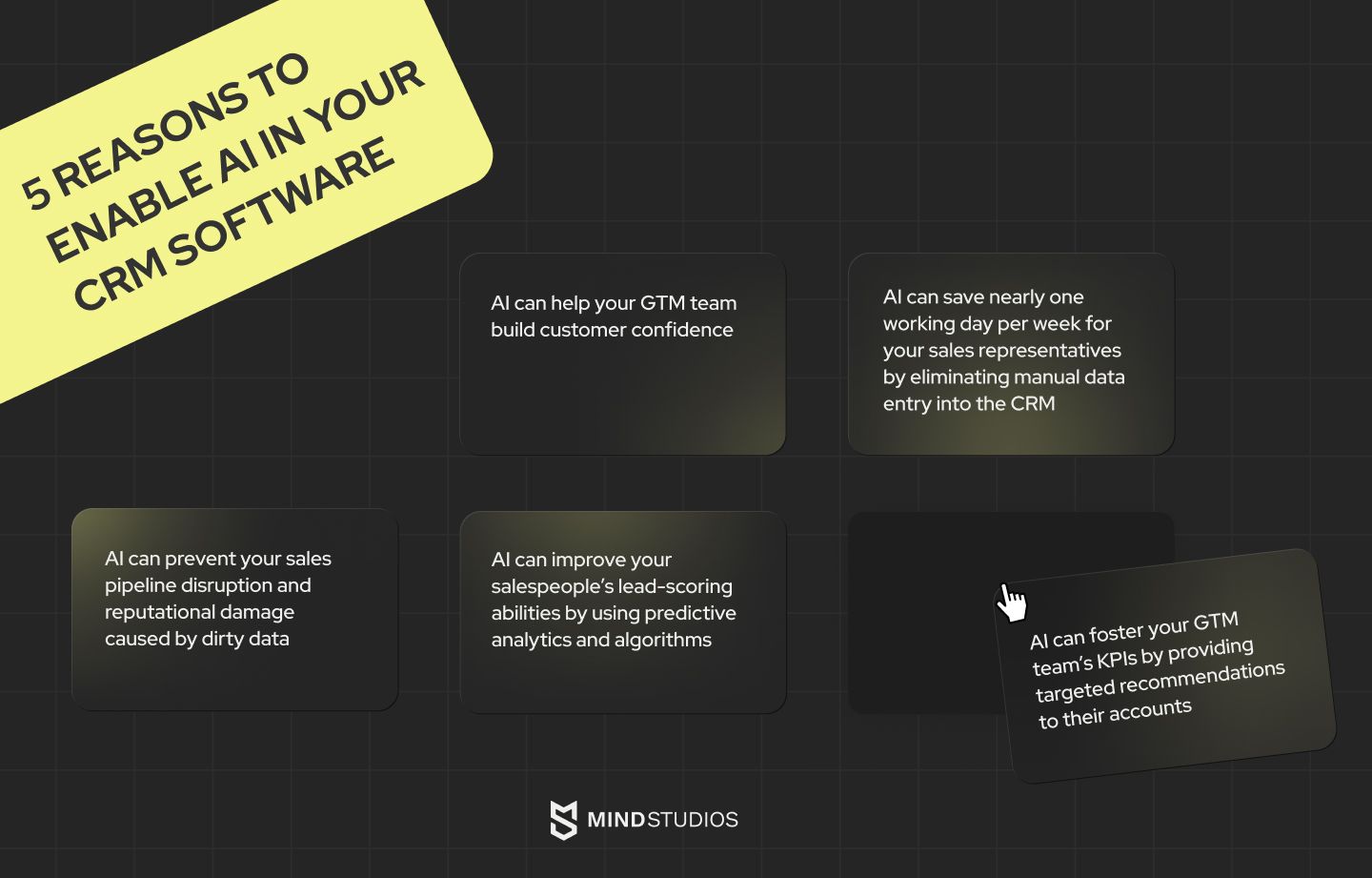
You’ve already learned what basic features typical CRM systems include. Depending on your business needs, this functionality may be enough to build your own CRM software. However, this won’t work if you aim to build a competitive CRM system to offer it as a SaaS solution to other companies.
Today, the demand for digital tools for go-to-market (GTM) teams is rising exponentially. Artificial intelligence and data science technologies play a big role here. On the one hand, three out of four CRM users are willing to switch to a different CRM platform to benefit from AI capabilities. On the other hand, savvy investors consider AI-powered startups a top investment priority for 2022 and beyond.
By combining the needs of both sides, AI-powered CRM startups including Glia, Winn.AI, and Breyta have successfully raised funds in 2022. Years before, the CRM SaaS behemoths have provided their own AI-powered tools: Salesforce established Einstein, Zoho integrated Hint, SugarCRM — Zia, etc.
What if AI technology is just a fancy add-on that costs a lot but serves no purpose for your custom CRM software development? We'll give you five reliable reasons why it is not:
- AI can save nearly one working day per week for your sales representatives by eliminating manual data entry into the CRM. With the help of AI, your salespeople get a single view of the whole customer interactions cycle gathered from disparate sources: emails, phone calls, chatbots, social media, etc.
- AI can help your GTM team build customer confidence. With an AI-backed sentiment analysis tool integrated into your custom CRM software, your employees can analyze conversations with customers, assess their emotional states, and therefore, think over the best way to respond.
- AI can prevent your sales pipeline disruption and reputational damage caused by dirty data. The thing is that 91% of data in CRM systems is incomplete, 18% is duplicated, and 70% is becoming obsolete each year. AI-powered tools can detect duplicates, irregularities, and other errors automatically along with identifying gaps in records and updating records as data changes.
- AI can improve your salespeople’s lead-scoring abilities by using predictive analytics and algorithms. It means analyzing tons of different historical and real-time customer data like demographics, geographic data, web behavior, social-media activities as well as won and lost deals. When integrated into your CRM software, AI tools can help your salespeople determine your customers’ buying readiness.
- AI can foster your GTM team’s KPIs by providing targeted recommendations to their accounts. Thanks to AI algorithms, for instance, your salespeople will be aware of what customers/prospects to reach, at what time, and with what message. What’s more, AI tools help to increase upselling and cross-selling.
Data migration from your legacy CRM or spreadsheets
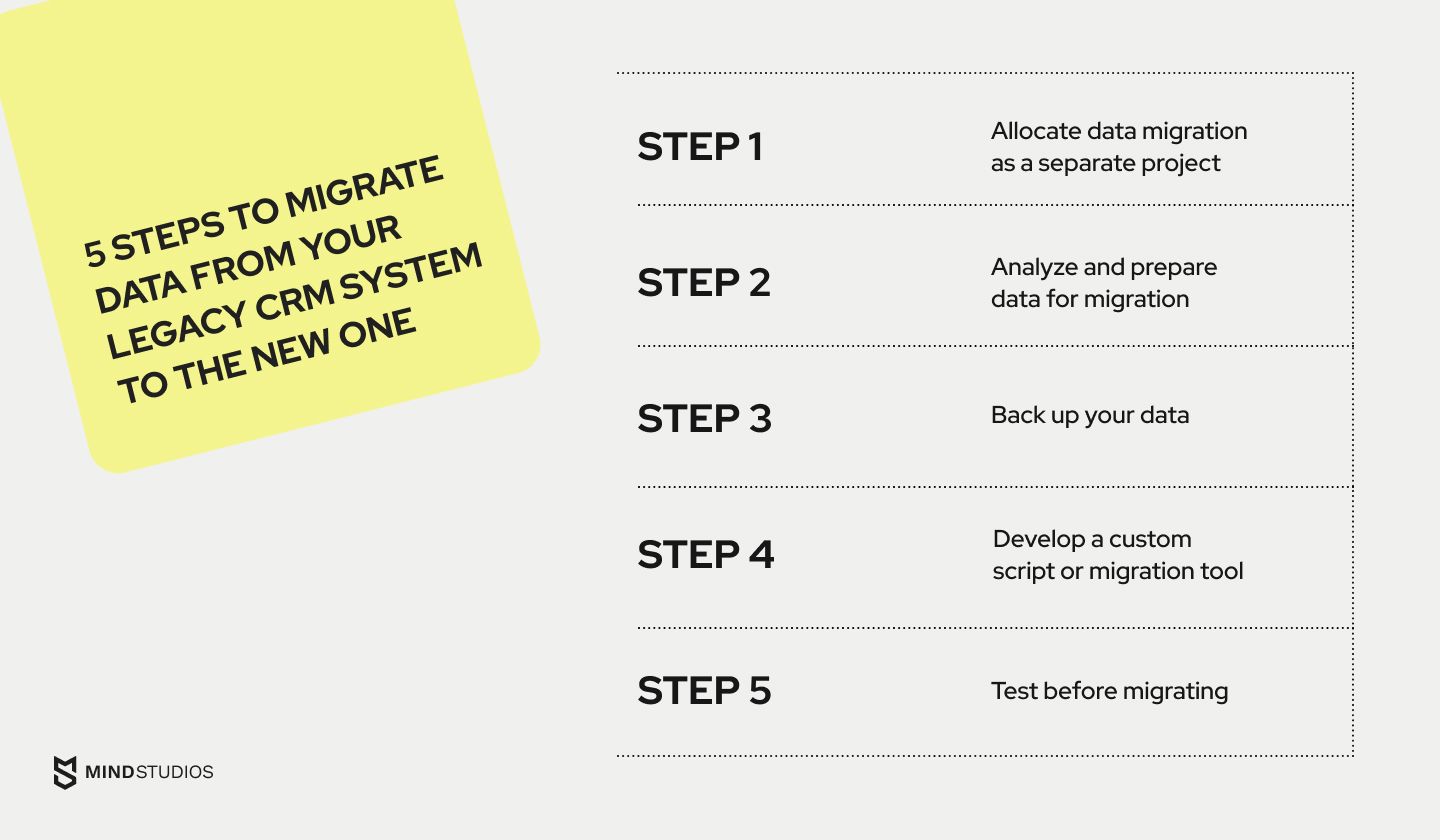
When it comes to your own CRM system development, chances are you bump into the need to transfer data from your legacy CRM system to the new one. Since the data migration process is no easy feat, we offer you a five-step guide on how to do it right, without losing valuable customer data:
Step 1. Allocate data migration as a separate project. Like with the CRM software development itself, you should define the plan, approach, budget, deadlines, and team for migrating data from your legacy CRM system to the new platform.
Step 2. Analyze and prepare data for migration. Define what CRM data you need to transfer and what should be deleted. Also, resolve how many tiers of historical data you want to transfer into the new system.
Next, get rid of duplicated, outdated, and corrupt data. As for the rest of the data, check that it is of the correct standard and format and suitable for the new CRM system requirements. Once you do this, you need to create a data map to outline what data goes where.
Step 3. Back up your data. Since the data you plan to migrate from your legacy CRM system to the new one is highly valuable for your business, you definitely need to make a backup of it in case something goes wrong.
Step 4. Develop a custom script or migration tool. To transfer data between two CRM systems, it’s better to create a data migration tool. This way, data gets transferred via API calls, which works particularly well if your original CRM has third-party software integrations that need to become a part of your new CRM.
Step 5. Test before migrating. After you create your data migration tool, it’s important to test it. For this, instead of transferring all data in one go, you can use a dry run. As a rule, using a data migration tool allows running sandbox testing. This, in turn, empowers you to perform as many trial migrations as you need for honing your data migration tool.
Connection of communication channels in CRM Systems
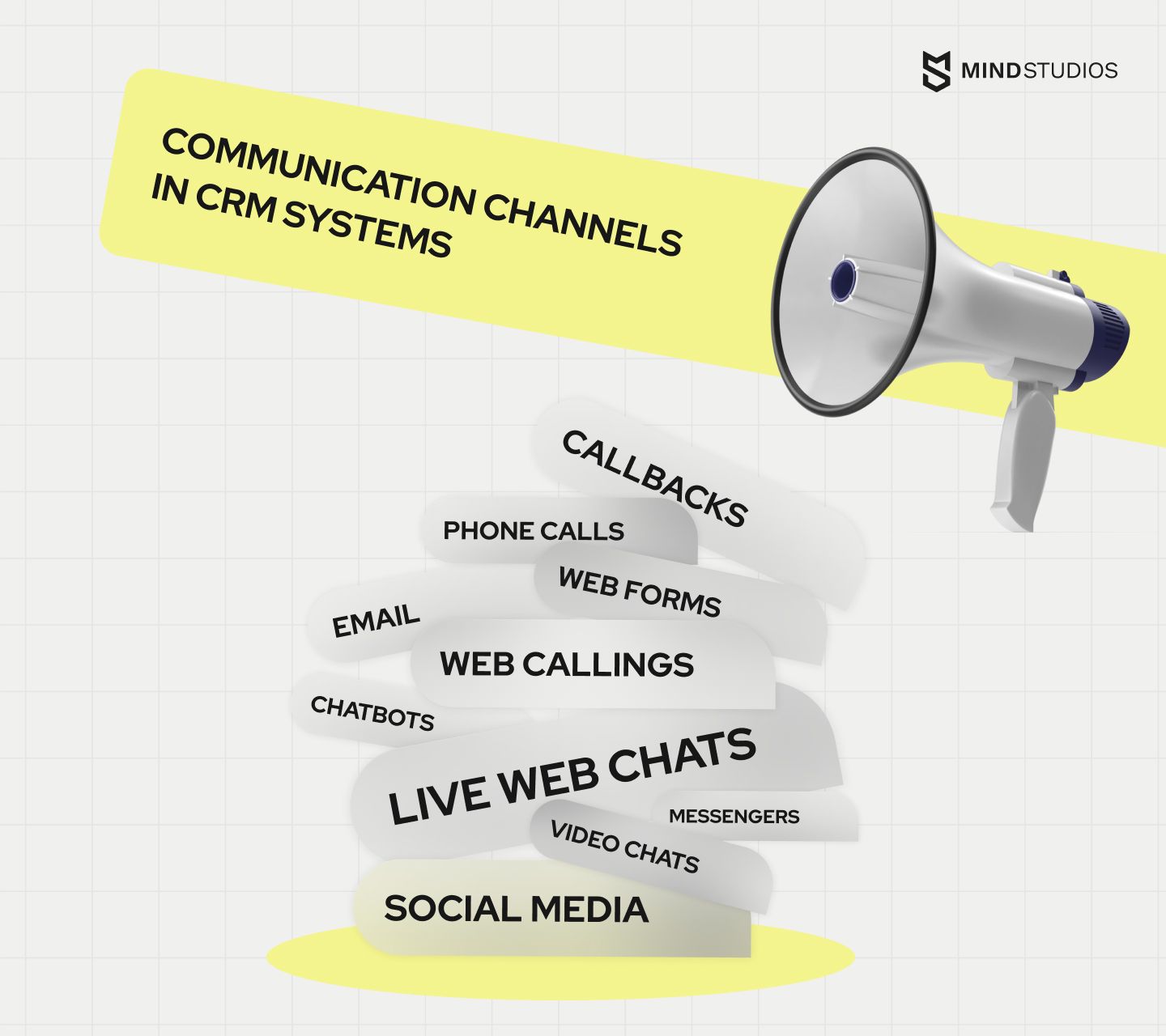
Communication is at the core of any CRM system. CRM platforms compete with each other by providing a wide range of communication channels for users and their customers — the more, the better.
Information flooding into CRM can come from at least 10 communication channels:
- Live web chats
- Chatbots
- Messengers
- Social media
- Web forms
- Phone calls
- Web callings
- Callbacks
- Video chats
Whatever communication options you decide to offer your customers, your custom CRM software needs to collect, analyze, systematize, and store customer data received from them. How to build a custom CRM software that integrates multiple communication channels so that they work smoothly?
The best option to integrate communication tools into your CR system is via application programming interfaces (APIs). We at Mind Studios frequently use Twilio APIs, WebRTC, and RTMP protocols to set up robust solutions for video, voice, email, and SMS communication.
If you’d like to make phone calls directly from your custom CRM software, you need to take care of Voice over Internet Protocol (VoIP) integration. Once you already use one of the VoIP tools, you can use their APIs to integrate with the new CRM platform.
You can use APIs offered by social media platforms including Facebook, Instagram, LinkedIn, Twitter, etc. to connect your CRM system with your corporate account. It also enables you to access your customers’ social media updates to have a clear picture of how they interact with your website, social posts, and landing pages.
The same approach works for integrating with your customers’ favorite messengers. Through APIs of WhatsApp, Telegram, Messenger, you can configure smooth communication with customers while detecting necessary customer data and storing it in your CRM system.
The need to integrate custom CRM with other software
Apart from communication tools, more often than not, you’ll need to integrate your CRM with other tools to do your business efficiently. Here is a rundown of possible options:
- Email integration to enable your CRM users to use customer data for creating personalized email templates and to collect data from customer responses to hone marketing campaigns.
- Calendar integration to allow your CRM users to effortlessly schedule and carry out customer interaction initiatives as well as seamlessly plan their own day-to-day activities.
- Marketing automation integration that helps better connect your marketing and sales teams and get them to better understand your customers by putting all customer information in one place.
- Team communication integration to streamline the internal collaboration of all your GTM team members by automatically sending/receiving emails or notifications from colleagues within one CRM platform.
How much does it cost to build a CRM system?
Most CRM solutions are originally built for the web. That’s understandable — most customer relationship management work is done from the computer, not on the go. However, a mobile version of your app can bring certain benefits.
For example, it’s easier to record and/or log phone calls if they’re made from an app. Push notifications can also be implemented in mobile apps; they’re considered the most effective reminders today. Having built a CRM application that syncs with the web version of CRM software, you’ll have the most complete solution.
The cost to create a CRM from scratch will depend on whether you choose to stop at web development or decide to go for a mobile app. However, it’s not only this that will impact the cost.
“When it comes to the custom CRM development cost and where to save money, I recommend saving on the frontend part of the project by making an artless UI design. Of course, it will work provided that the software is used internally and not designed to be sold as a SaaS.
Creating an intuitive user interface and integrating necessary third-party systems is what you should pay attention to in CRM system development. Depending on how many integrations your custom CRM project requires, this part of the development process could be the most costly.”— Anton Baryshevskiy, Mind Studios Co-founder and Head of Business Development
To build a custom CRM website with the help of an outsourcing web development company, you’ll need the following specialists:
- Project manager – 1
- UI/UX designer – 1
- Frontend developer for the user-side app –1
- Backend developer for the server-side – 1
- QA specialist – 1
Web apps are usually cheaper and easier to build than mobile apps. So if you decide to dive into custom CRM development for mobile, you’ll spend more. You’ll also need more people working on your app in addition to those listed above:
- +1 UI/UX designer
- iOS developer – 1
- Android developer – 1
You can choose to make a mobile app for only iOS or only Android, of course, depending on what your employees use.
Without further ado, let’s take a look at an approximate budget you’ll require to develop a solution with the above-described features for custom CRM systems:
| Stage | Time (hours) | Cost (USD) |
|---|---|---|
| Discovery stage | 100+ | 4,500 |
| UI/UX design | 160 | 7,200 |
| Frontend development | 820 | 36,900 |
| iOS development | 380 | 17,100 |
| Android development | 400 | 18,000 |
| Back end + admin panel | 980 | 44,100 |
| Quality assurance | 490 | 22,050 |
| Project management | 410 | 18,450 |
| Total | 3,740 | 168,300 |
Summarizing the above, a CRM software development cost will start at $110,000 and go up depending on the number and complexity of features and third-party integrations you’re implementing. As for the time, it will be roughly 7 months or more. Building a CRM system for iOS and Android can cost you an extra $18,000 and up for each platform and take additional 2 months to be developed.
Mind Studios' experience in custom CRM development
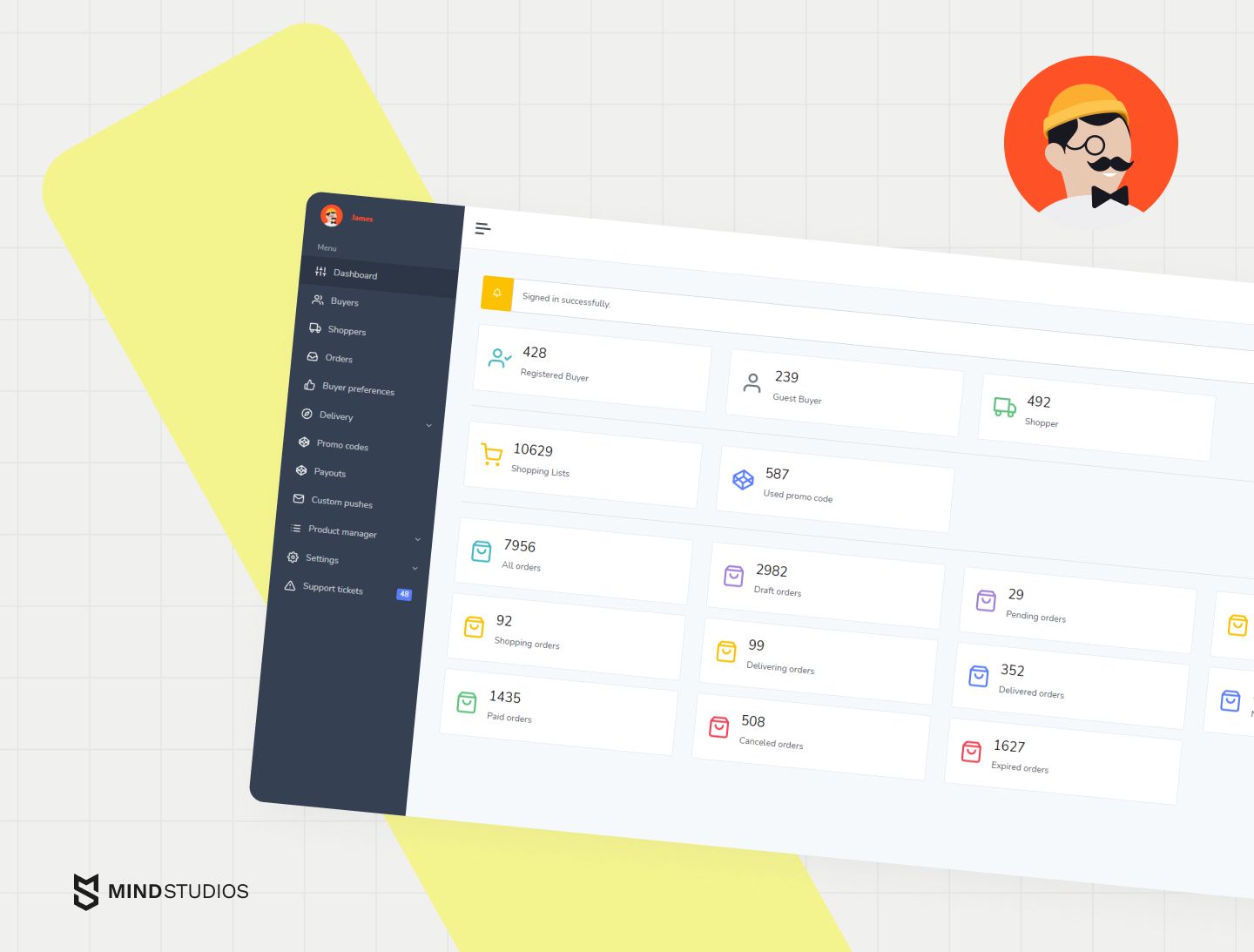
As we previously told, we try to equip every project we develop with some sort of CRM system. However, there were projects with rather complex functionality where creating a custom CRM system required prominent skills, so we’d like to share this experience with you.
One such project is James Butler, a delivery service in Denmark for which we built four mobile apps: two for customers and two for delivery people on both iOS and Android platforms.
This ecosystem is rather complex since it involves several types of users including a system itself, a customer, and a courier, and tracks interactions among them. In the James Butler app, customers and delivery people are able to leave reviews to each other and bargain over the cost of delivery, in addition to traditional features such as tracking delivery status or providing instant payments.
In this project, the admin panel we made evolved into a full-scale CRM system where the administrator can monitor the status of each order, see all new orders and their status, handle customers’ and delivery people’s feedback, provide customer support, track bargains, and more.
Custom СRM development: Summing up
In today’s market, customer relationship management software can be a deciding factor in which a company succeeds. CRM systems improve marketing and sales performance. By automating what can be automated, CRM software redistributes employees’ efforts and optimizes the workflow.
Investing in a CRM system is never a waste of time and money provided that your CRM software development team knows what they’re doing.
Mind Studios has relevant experience in building CRM systems of any complexity, and we can also help you expand your software development team or create it from scratch, becoming its basis.
If your project is focused on the other service not directly related to developing a custom CRM system, we’ll help you choose the right configuration for your CRM tailored to your business needs. If you want to build a SaaS CRM solution, we are here to bring your product to the market on time and on budget.
All you need is to drop us a line via our contact page, and you'll get answers to all questions regarding custom CRM development and a more precise cost estimate.

